

Iron acetate is a common wood stain, typically made by dissolving steel wool in vinegar. While simple and inexpensive to make, it also has a reputation of being fairly inconsistent; the final color of the wood can range from a deep brown to a pale green-gray. Through experimentation, I found that this is generally a result of having a poor understanding of the stain solution, and consistent results can be achieved if certain specific steps are taken.
The common understanding of this type of stain is that iron acetate reacts with tannic acid in the wood to form an iron tannate complex (like that found in iron gall ink) and free acetic acid, which evaporates away; however, this is only responsible for the overall shade of the wood, and produces no color. This is why other iron salts (sulfate, chloride, etc.) will only turn wood gray. Iron acetate, however, has two very different forms depending on the oxidation state of the iron (+2 or +3). Iron (II) acetate is water-soluble and nearly colorless, whereas iron (III) acetate is insoluble and a dark red-brown. When iron (II) acetate is exposed to air, it is rapidly oxidized to the colorful iron (III) acetate. If this happens within the fibers of a piece of wood, the wood is then permanently stained.
To achieve this, I began with a pint of vinegar in a mason jar, to which I added a pad of #0000-grade steel wool. This is a large excess of iron, and most of the steel wool will remain undissolved. I then heated the mason jar to a simmer in a water bath, with the lid resting on the jar to exclude air and contain the vinegar fumes. The lid could not be tightened down, however, due to the hydrogen bubbles produced by the reaction. Occasionally the solution would begin to turn orange and hazy, at which point I would open the jar and stir the solution until it became clear again; my assumption is that the iron (0) in the steel wool reduced any iron (III) to iron (II). Eventually, the solution became a light green and the bubbling began to slow down, at which point I turned off the heat. In early experiments I would then pull the steel wool to the bottom of the jar with a magnet, but I found that the solution would then quickly oxidize, even with the lid on. If the steel wool is allowed to float, however, it acts as an oxygen barrier and the lower solution remains clear for weeks, to be extracted as needed with a pipette. The stain solution can be seen below, along with the results of air exposure, starting with 10mL of fresh solution and proceeding in one-hour increments.
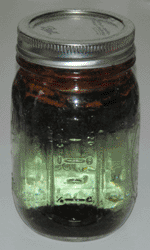
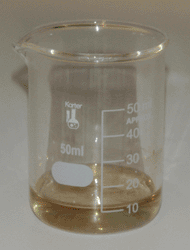
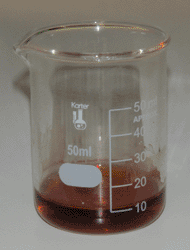
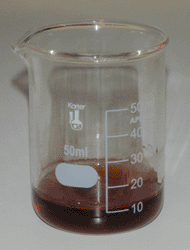
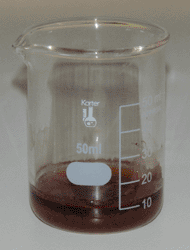
To test this stain I cut strips from three different kinds of wood, and painted half of each strip with strong black tea (four bags per cup of water) to increase the tannic acid content. Once the tea had dried, I then painted the strips with fresh stain solution, and waited three hours for the reaction to complete and the wood to dry. Finally, I buffed the strips with a rag to remove any iron (III) acetate residue from the surface. The finished pieces can be seen at the top of the page. In general the results are satisfactory, and the tea pre-treatment was effective at darkening the stain while retaining its color. Stronger or weaker tea could easily be used to provide a range of shades, possibly extending all the way to black. The only limitation I encountered is that diluting the solution tends to oxidize it, making it difficult to achieve lighter shades without the wood becoming gray and washed-out. Fortunately, I intend to use this exclusively as a very dark stain, so this limitation is irrelevant for my purposes.
Since writing this article I have used this wood stain on a number of projects, and have found it to be highly reliable. The only exception is on woods high in tannins, in which case the stain turns the wood black. However, these woods can be ammonia-fumed instead to achieve a very similar shade of brown, and these two processes have become my go-to methods for achieving a dark finish on wood. This wood stain has also become very important as a drying catalyst for oil-based finishes, and in general has become a central feature of my woodworking methods. As such, I have recorded a video on its preparation, which can be seen below.
EDIT: 5/2/2025Continued use of this wood stain has revealed a number of interesting properties. First, I have found that the stain becomes much more consistent if it is applied over a layer of thinned (5% solids by weight) protein glue (either gelatine or casein) used as a primer, also known as glue size. Iron-protein compounds are the same color as the stain itself, and the glue layer prevents the stain from absorbing unevenly into wood with irregular grain. This also renders the glue permanently insoluble in water, and as such may even be useful outdoors. Next, I have found that a 5% solution of oxalic acid is capable of erasing this wood stain when brushed over it, even when the stain has been applied over glue. Finally, after investigating the exact quantity of tannins necessary to achieve various shades of brown, I determined that imitating darker wood colors generally requires pre-treatment with a solution of between 0.5% and 2.0% tannic acid. Below this range the stain is essentially unchanged, and above this range the wood is blackened. This tannin treatment is also compatible with protein glues, since tannins render proteins insoluble, similar to the process of making leather.